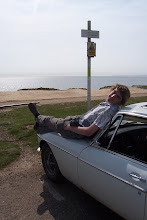With rear chassis rails now in the correct places, and a nice new boot floor to support the petrol tank, spare wheel and fuel pumps, it’s onwards to the rear wheel arches. But first, the rear chassis legs required more repairs which I could not do until the arches were removed. And there will be even more repairs when she’s on her side again for paint. By repairs to the rear chassis rails, I mean removing the bad bits and replacing them with new, so many areas have needed replacement that, despite seaming and using heavy gauge steel, I added some internal reinforcement to make up for any strength which had been lost after the repairs were carried


And as the rest of the wheelarch was cut away this was the state of the rear chassis legs on both sides. Nasty. They required new bump stop reinforcers, much replacement and fabrication of new sections, some internal reinforcement to increase strength and they were only considered done when all steel was clean and satisfactory. As an aside, note the penetration towards the rear from welding on the new boot floor, it appears I had the power exactly right to join to this thicker grade of steel.
Finally they were both in the correct shape to accept the new rear arches. As usual all the attachment areas and flanges were cleaned to the rustless spotless finish, I’ve been using Jenolite for quite a while now. A quick note about this.
Mark and Nigel swear by this stuff, but I don’t seem to get on very well with it. I presumed that being acid based, it would eat away the oxide, but even after applying it then wire brushing there are still areas of rust left in the pitted areas. Am I being stupid, is it only intended to stabilise the surface rather than actually remove the “dead” rust? The more expensive and not so nice to use Bilt Hamber Deox gel completely removes all traces of rust and gives a shiny clean steel surface, which is what I am after. However it then needs washing off with water, which I don’t like the idea of. I have still to find a completely ideal rust removal system. A big compressor and shot blasting set up will probably be used next time. However, several cycles of Jenolite and wire-brush-in-the-drill eventually clean the flanges, although this may well be due more to the wire brushing than the Jenolite. It tastes quite good too I must admit, but a bit sharp. Oh, that would be the phosphoric acid…
The sill end fillers were welded into place at the back. Then all contact areas were primed, and one side at a time the new wheel arches were welded on, plugged then seamed., to the rear chassis rails, the inner panels below the C posts, then to the sills at the back. Despite being very large and ungainly, they fitted in without further ado. Excellent.

The offside had been done, now the nearside has as well. Don't you just love all the fresh steel?

No comments:
Post a Comment